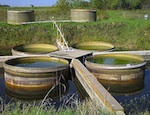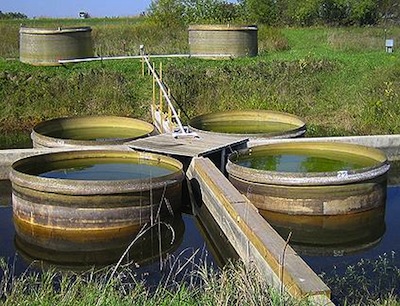
Process for wastewater algae to biocrude
February 21, 2013
By University of Kansas
 February 21, 2013, Lawrence, KS – A team at the University of Kansas has demonstrated the feasibility of an integrated wastewater algae-to-biocrude process using hydrothermal liquefaction (HTL) that can sustainably cultivate algal biomass for biofuel production.
February 21, 2013, Lawrence, KS – A team at the University of Kansas has demonstrated the feasibility of an integrated wastewater algae-to-biocrude process using hydrothermal liquefaction (HTL) that can sustainably cultivate algal biomass for biofuel production.
A paper on their work is published in the ACS journal Energy & Fuels.
This study is the first of hydrothermal liquefaction of wastewater-derived microalgae, the team said. The municipal wastewater matrix and resultant mixed-culture biomass significantly influenced liquefaction product distribution, yielding a higher proportion of biochar, which may be a valuable co-product, they found.
“Traditional conversion technologies of algal biomass to biofuels have mainly included lipid extraction or pyrolysis for biodiesel, hydrotreated renewable diesel, or bio-oil production. These technology pathways have significant drawbacks when using algal feedstocks. Lipid extraction requires extensive dewatering and organic solvents, diminishing the economics of fuel production and increasing environmental concerns,” the study reads.
“Whole cell conversion pathways, such as pyrolysis, alleviate environmental concerns from solvent extraction but still require extensive dewatering prior to conversion. A wet whole cell conversion pathway, hydrothermal liquefaction (HTL), has gained popularity in the past few years.
 |
|
| A team at the University of Kansas has demonstrated the feasibility of an integrated wastewater algae-to-biocrude process using hydrothermal liquefaction (HTL). |
“HTL uses subcritical water as the chemical driving force to convert biomass to a carbon-rich biocrude. Using microalgal feedstocks, biocrude yields from HTL processing are 5−30 per cent greater than the initial algae lipid content because other cellular components (beyond only lipids) are converted to biocrude. Economic analyses of producing fuel oil, synthetic gasoline, and diesel from wood chips with 50 wt per cent moisture have shown that atmospheric flash pyrolysis is less costly than high-pressure liquefaction.
“However, for high water content biomass, such as algae, the energy costs of dewatering may offset the energy demand of liquefaction processes. Also, HTL of algae gives a biocrude with a composition and energy density that more closely resembles petroleum crude than bio-oil from pyrolysis.
“…While municipal wastewater is a readily available water and nutrient source that can support mass algal biomass cultivation, wastewater effluent has dynamic nutrient concentrations that vary daily and seasonally. This variable nutrient source is entirely different from the nitrogen-limited growth conditions that are known to yield high-lipid content biomass, such as 40−70% lipid by weight. Wastewater-fed algae typically have low lipid [10−29 per cent dry weight (dw)] and low carbon (30−37 per cent dw) contents, and these characteristics can have substantial effects on the HTL product formation and biocrude composition,” the study reads.
The process developed by the researchers used pilot-scale algal cultivation ponds fed with municipal wastewater as the nutrient source. The open ponds were self-inoculated from the wastewater source, resulting in a mixed-culture microalgal community with distinct differences compared to laboratory-maintained and fertilized monocultures.
GC/MS analysis of the biocrude contained a significant number of straight-chain and branched hydrocarbons and mono- and polyaromatics in addition to fatty acids.
“The co-products could greatly enhance sustainability and the value chain for algal biofuels, adding markets in carbon sequestration, soil amendments, absorbents, and fertilizers. This promising demonstration requires further work upon optimizing the energy balance of the conversion method in conjunction with the cultivation strategy and determining the efficacy of the identified co-product markets,” the study added.
Print this page